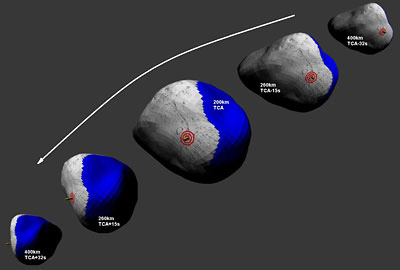Spacecraft and comet fated for Valentine's Day rendezvous
By Lauren Gold

In the beginning, both couples seemed meant for each other.
There was the Stardust spacecraft, launched in 1999, and her cometary fiancée, Wild 2. Betrothed from afar, the two headed blissfully toward a 2004 rendezvous.
Meanwhile, the comet Tempel 1, making her own solitary way around the sun in 2005, was heading toward a more explosive relationship with the Deep Impact spacecraft.
But alas, heavenly though the matches were -- and fruitful, with each yielding valuable information about the evolution of the solar system -- neither lasted. In 2006, Stardust tossed her dusty tokens of Wild 2 down to Earth for analysis and vowed to start anew. She was a little older now; but with all her parts in good working order and adequate fuel, she was ready for a second mission. And Tempel 1, scarred by her violent encounter with Deep Impact, was looking for a kinder, gentler match.
On Valentine's Day, the two will meet. In the heat of the moment, astronomers hope, Tempel 1 will be cajoled into yielding a few more clues about her background. And Stardust, equipped with imaging and dust composition analysis instruments, will relay those clues to Earth.
The expectant matchmakers
Among the astronomers waiting patiently are Joe Veverka, professor of astronomy and principal investigator for Stardust-NExT, the NASA mission orchestrating the rendezvous.
The Valentine's Day flyby could yield a wealth of new information about Tempel 1's structure and composition, Veverka said, and how its features change with every passage around the sun.
"We know that comets lose material," he said in a recent press conference; "But the question is 'How does the surface change, and where does the surface change?'" Comparing the 2005 images with the new ones -- taken one rotation around the sun later -- could provide the answer.
Stardust could also catch a glimpse of the crater that formed when a probe from Deep Impact crashed into Tempel 1's surface six years ago.
"That impact threw up so much ejecta that Deep Impact never saw the crater," Veverka said. "So it could never see how big the crater is and what [it] tells us about the mechanical properties of the surface."
That information is vital for any future mission that involves landing a spacecraft on the surface of a comet, he said.
And finally, astronomers hope the rendezvous will provide a closer look at some of the surface features Deep Impact saw when it zoomed by in 2005. Layered terrain, for example, could contain information about how comet nuclei were formed; and smooth flows hint at some internal processes that could be working their way up to change the surface.
"Deep Impact saw only about one-third of the surface," Veverka said. "We would like to see more."
So -- as Feb. 14 approaches and other romantic souls plan candlelight dinners, Veverka and colleagues are tracking the pair, now hurtling toward each other at about 590,000 miles a day.
Stardust caught its first glimpse of Tempel 1 Jan. 26. It will keep its eye on the comet as it approaches, collecting data to help mission navigators refine its trajectory.
Close encounter
And on Valentine's Day, as Earthbound lovers gaze into each other's eyes, the two orbiting bodies will meet, about 120 miles apart. As they pass, Stardust will test the density and composition of the dust surrounding the comet and snap 72 high-resolution images.
Researchers expect to receive the data within a few hours of the closest encounter. "The science team is awfully excited," Veverka said.
And thus, perhaps, the curtain will close on this cometary encore. But as with all concluded affairs, there will be months -- perhaps years -- of data analysis; and ultimately, plans for the next mission.
"Comets preserve some of the most faithful information about what happened when the solar system formed," Veverka said. "This is a step toward the ultimate answer."
Stardust-NExT is managed by JPL, a division of the California Institute of Technology in Pasadena, for the NASA Science Mission Directorate. Lockheed Martin Space Systems built the spacecraft and manages day-to-day mission operations.
Get Cornell news delivered right to your inbox.
Subscribe